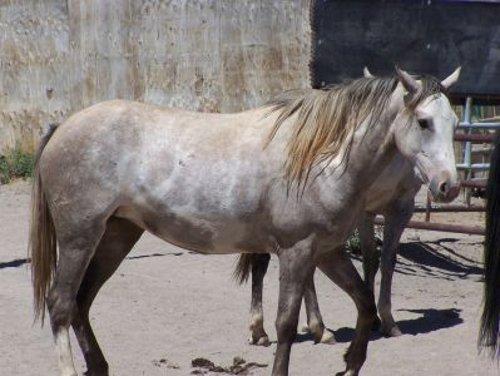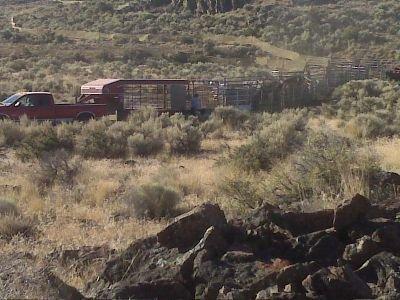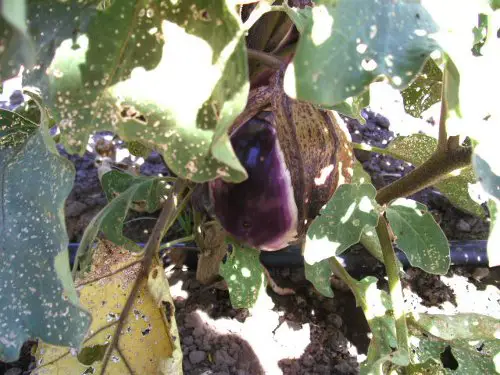
A mare taken in during the Bureau of Land Management's wild horse roundup in the Twin Peaks Herd Management Area near Susanville, Calif., on Friday, August 13, 2010. Just before the picture was taken the mare received her vaccinations and deworming, and was waiting to be turned into pens at the Litchfield Corrals not far from the roundup area. The BLM said the horses in the herd usually are bay or brown. While this mare's markings are unusual, the agency said there are quite a few pintos in the group that exhibit similar subtle, irregular spotting that is low on the body. Photo courtesy of the Bureau of Land Management.
THIS ARTICLE HAS BEEN UPDATED WITH ADDITIONAL INFORMATION ABOUT BLM HERD MANAGEMENT AREAS IN CALIFORNIA.
NORTHERN CALIFORNIA – Federal officials have begun a six-week operation to gather horses from one of the state's biggest mustang herds, a roundup that's expected to be California's largest this year and the second largest in the nation.
The roundup of wild horses and burros from the 798,000-acre Twin Peaks herd management area – located 25 northeast of Susanville along the California/Nevada state line – began Aug. 11, according to Bureau of Land Management spokesperson Eric Curtis.
“Our goal is to round up as many of the horses as we can and leave about 450 of them on the range,” said Curtis.
A roundup in the area hasn't taken place since 2006, Curtis said.
The operation started the same day the federal Ninth Circuit Court denied an injunction to stop it, the BLM reported.
That injunction was filed July 15 by In Defense of Animals along with ecologist Chad Hanson, wild horse sanctuary founder Barbara Clarke, DreamCatcher Wild Horse and Burro Sanctuary and wild horse enthusiast Linda Hay.
In Defense of Animals and its fellow plaintiffs in the July federal court filing cited the deaths of 12 mustangs in a Nevada roundup in July among its criticisms of the BLM roundup operations, saying that the “mass and illegal removal” of the federally protected mustangs “serve the livestock industry and other commercial interests that exploit our public lands.”
After conducting ground and aerial assessments of the herd management area, the BLM concluded it could move forward with the roundup, originally scheduled to begin Aug. 9.
District Manager Nancy Haug said BLM crews found that the more than 2,000 wild horses and more than 200 wild burros due to be rounded up appeared in good condition and showed no visible signs of dehydration.
However, Haug stated, “The current population of wild horses and burros remains far above the number the range can handle, and this roundup is necessary to keep both horses and range in that healthy state.”
She said the BLM was taking special precautions for the heat during August and early September. Helicopter gathers aren't conducted during the foaling season, which Haug said happens between March 1 and June 30, in order to ensure foals are strong enough to be moved with their mothers.
On the roundup's first day, 119 wild horses were gathered before noon by the BLM's contractor, Utah-based Cattoor Livestock Roundups, and transported to temporary holding facilities, the BLM reported. The animals were reported to be in good condition and health, with high body condition scale ratings.
The following day, Aug. 12, another 164 horses were gathered, including 61 studs, 72 mares and 31 foals, the BLM reported.
One older mare was euthanized that day due to a pre-existing injury, and one small foal fully recovered from difficulties the night before and was reunited with its mother, officials reported.
By Friday, 370 horses had been gathered and 253 had been shipped to the Litchfield Corrals east of Susanville, the BLM reported. Reports weren't available for Saturday or Sunday.
In addition to Litchfield, horses also will be transported to the Palomino Valley Center, which is located in Nevada not far from the herd management area, Curtis said. The goal is to minimize the time the animals spend in trucks.
The Twin Peaks herd traces its ancestry to a variety of sources, according to the BLM. While some of the original horses in the area came from Spanish stock, many of the horses are descended from US Army Cavalry horses prior to and during World War I, as well as draft and light breed ranching stock.
Curtis said some of the herds in the region exhibit heavier draft horse characteristics and therefore tend to be larger than the usual mustang.
“They are just beautiful,” she said, adding, “They're quite healthy.”
The herds don't show signs of dumped domestic horses. Although domestic horses are turning up in some herd areas in the nation because their owners can't afford to keep them, the animals don't have an easy time of it, said Curtis.
“The wild herds don't take kindly to those horses,” which Curtis said “often get pretty beat up” and don't know how to forage or survive on the range.
She said the Twin Peaks horses are mostly brown and bay in color, they're good-sized – 14 to 16 hands and 900 to 1,100 pounds – and are good for endurance.
The BLM said the animals live in a high desert environment, with limited grass resources on a rugged landscape.
The Twin Peaks horses are expected to be popular at adoption events the BLM is planning to hold around the state, Curtis said.
The adoption events also come to the North Coast; the last one in Lakeport took place June 5, as Lake County News has reported.
Those who adopt the horses are required to provide information to BLM of where and how the horses are being kept, said Curtis.
“We have folks who follow up with them over the course of a year,” she said.
The measures are intended to prevent neglect and stop the horses from being picked up for slaughter, she said.
It's only after the horses have been kept satisfactorily for a year that ownership is handed over, said Curtis.
If the horses aren't being properly cared for by their new owners, Curtis said the BLM takes them back.
If the horses aren't adopted after a certain period of time, most will be taken to the Midwest to longterm pastures, Curtis said.
Others will go to programs in Colorado and Nevada where prison inmates train the horses, Curtis said.
The BLM sends some of the horses there, and still others go into the “extreme mustang makeover program,” where she said teams of trainers compete to gentle the animals.
One such competition was just held in Colorado six weeks ago. More about that competition can be found at http://extrememustangmakeover.com/.
The Twin Peaks Herd Management Area is one of 22 in California, according to the BLM. Of the public land the federal agency administers in California, the wild horse and burro population covers 7.1 million acres plus an additional 2.3 millions acres of private land.

After an early morning capture of a small band, wranglers position a trailer to carry horses to the Litchfield Corrals near Susanville, Calif., on Friday, August 13, 2010, the third day of the Bureau of Land Management's mustang and burro roundup in the Twin Peaks Herd Management Area in Northern California. Photo courtesy of the Bureau of Land Management.
Mustangs being scapegoated, supporters say
In a January opinion piece on wild horses published in the Los Angeles Times, Interior Secretary Ken Salazar wrote, “We need a comprehensive and balanced approach built on new partnerships, new thinking and new courage to tackle an issue that, unfortunately, has no easy solution.”
He suggested fertility control, eco-tourism related to signature herds and public-private partnerships to establish new sanctuaries in the Midwest and East.
Advocates for the horses say that the current methods and policies used by the Department of the Interior and the Bureau of Land Management aren't working and aren't humane, and instead of roundups they support on-the-range management of the wild horses and burros as a means to maintain healthy herds and healthy range lands.
In Defense of Animals and other plaintiffs in the federal injunction filed last month alleged that the planned roundup at Twin Peaks violated the Wild and Free Roaming Horses and Burros Act and the National Environmental Policy Act in a “manner that is both arbitrary and capricious,” and accused the BLM of “crafting a solution and then searching for a problem.”
While wild horses are blamed for range damage by livestock grazing, the plaintiffs said that mustangs comprise only a small fraction of grazing animals on public lands, and are outnumbered by other livestock 50 to one. Meanwhile, the BLM has reportedly increased cattle grazing allotments in areas where the horses are being rounded up.
Of the 245 million acres managed by the BLM, cattle grazing is allowed on 160 million acres, and wild horses are on 26.6 million acres shared with cattle, wild horse proponents reported.
The groups also alleged that the Obama administration has accelerated wild horse and burro removal, with 36,000 wild horses warehoused in government holding facilities – which they called “zoo-like” – and only 33,000 wild horses free on the range.
Environmental attorney Rachel Fazio, who was involved with the July injunction, said the Department of Interior “has a policy of removing mass numbers of wild horses from the range without supporting its conclusion that such drastic measures are ecologically necessary.”
In addition, she alleged that the agency won't provide to the public the data to support the removals – which she said violates the legal requirements of the National Environmental Policy Act – and that it disregards the damage done by livestock.
The groups said the BLM authorizes up to four times more cattle than wild horses, and nearly seven times more sheep than burros in the Twin Peaks area, and that the agency has the legal authority to limit livestock grazing in order to make more forage available for wild horses and burros.
The BLM says it's done just that. The agency said it's worked with ranchers who run cattle on BLM-managed land to reduce livestock numbers by 50 percent compared to 30 years ago in response to available resources.
Daily updates on the Twin Peaks roundup can be found at www.blm.gov/ca/st/en/fo/eaglelake/wild_horse_and_burro/twinpeaksgather/gatreports.html.
See a video about the roundup here: www.blm.gov/ca/media/video/twinpeaksgather-2010/index.html.
E-mail Elizabeth Larson at This email address is being protected from spambots. You need JavaScript enabled to view it. . Follow Lake County News on Twitter at http://twitter.com/LakeCoNews and on Facebook at http://www.facebook.com/pages/Lake-County-News/143156775604?ref=mf .












